My daughter is very attentive to the insect population around our house. She spends many hours collecting all sorts of insects and other animals. In the fall of 2013 she brought me a leaf that she thought had a caterpillar of some sort on it. She is well aware that bugs make little houses in leaves and stems and after she realized that these little orange furry things were attached to the leaves she thought there must be a bug living inside of it. She was hoping I could open one up and show here the critter inside. I didn’t know what it was but a quick look at the oak trees in my yard revealed that there were a LOT of them as you can see in the picture below.
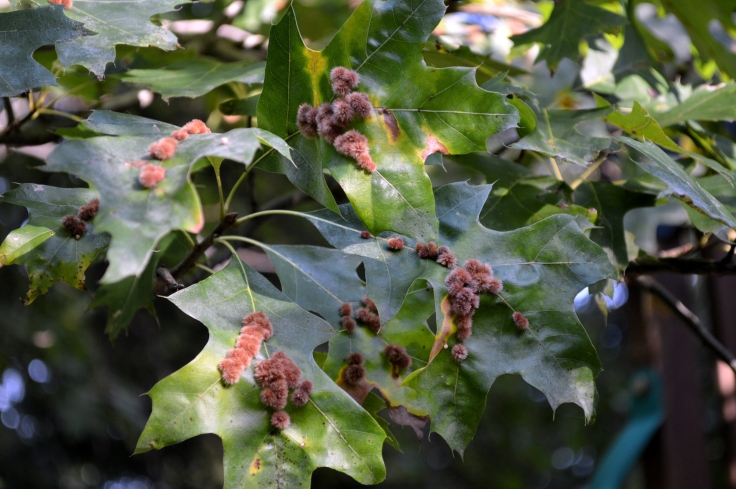
We have at least 10 large pin oak trees in our yard in addition to a few other in the neighbors. I did a quick scan of the lower branches and then calculated that there must be at least a half a million of these little fuzzy blobs on the leaves in less than an acre of land. Surprisingly, I also have a large white oak tree right next to a heavily infested pin oak tree and I have yet to find a single one on the white oak tree. What I found strange about these galls the first time that I saw them was that at the time we had lived in our current home for a bit over a year and I had no memory of having seen these on our trees that previous year. I don’t know how I would have missed them and yet in 2013 the trees were covered with these galls.
But what are they? A bit of searching revealed that they are a type of gall produced by a gall wasp. Most likely they are produced by the tiny gall wasp Callirhytis furva although there are a couple of other possible wasp species that produce galls similar to those we are seeing on our trees. Below are a few more pictures and a description what this gall wasp is doing.
The picture above and below show a few of these galls a bit closer. You can see that they are found along the main veins of the leaves to which they are attached. A very small wasp–barely visible to the eye–implants an egg into the growing leaf which then turns into a larva which then entices the pin oak tree to grow these galls which the larva then inhabit and use for protection while they mature into adults. Although the galls look nothing like the leaves or any other part of the tree they are made of plant tissues from the tree. Yes, the hairs and colors are plant tissue and not from an animal.


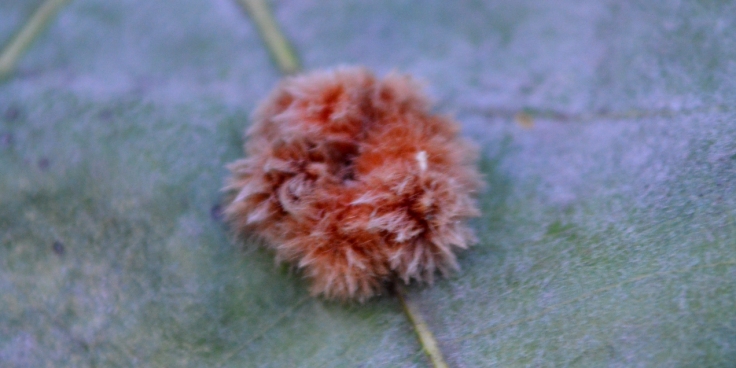
About three weeks later in early September the galls began to turn brown after having been a bright orangish-red color. By late September (in Ohio, presumably later further south and earlier further north) they begin to detach from the leaves and drop to the ground. The galls seem to have matured and before the leaves change and fall to the ground to rot these galls, detach themselves and fall to the ground where they will rest until the larva matures into an adult wasp and emerge from its protective home.
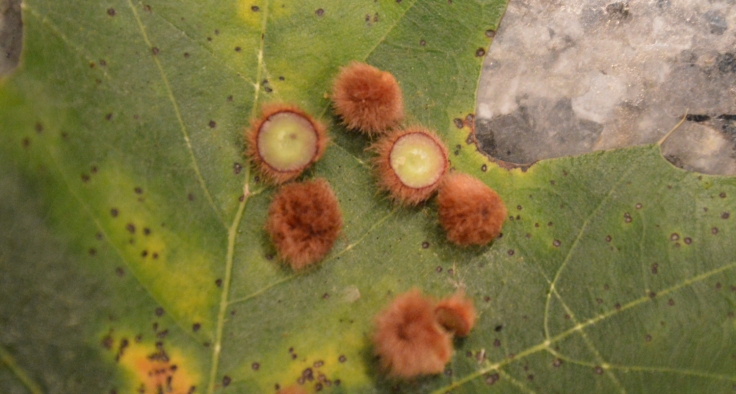
I plucked some galls off of a leaf and cut them open. They were quite solid. The small dot in the center is probably the tiny larva which is surrounded by thick plant tissues and a hairy exterior. Over the next year to two years the larva will eat away at the tissue in the gall using that energy to go through its developmental stages to eventually produce an adult gall wasp.
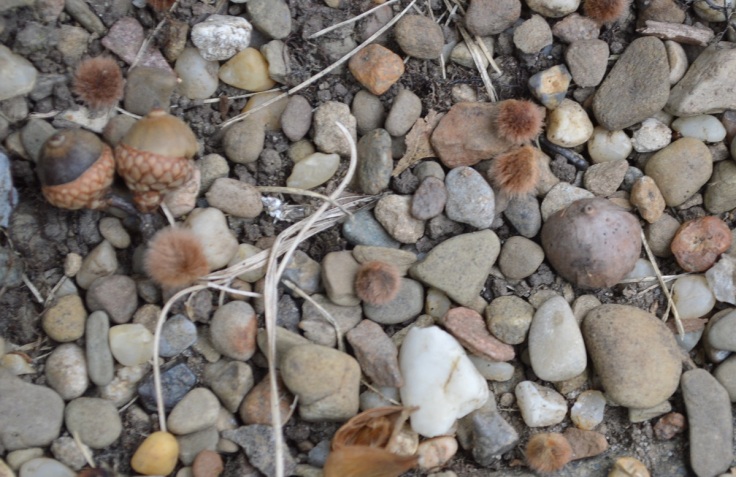
Above is a picture of some of the galls on the ground not long after I first noticed the galls. Soon the ground was just littered with these little brown fuzzy balls. From my reading I have found that it may take two years for the larva to mature to an adult and emerge from these little galls.
Interestingly, in researching these gall wasps I found reports from northeastern Ohio of these galls on oak trees from 2007, 2009 and 2011 with the latter two being reported from locations not more than 20 miles from where I live. The odd years suggest that it is a two-year cycle and this is why I did not see any of these galls on my trees last year. Well, I guess we had millions of little wasps flying around that weren’t with us last summer but we didn’t seem to notice. So next year I am expecting that I won’t see them but I am sure that my daughter will be watching each summer to see what shows up next.
The geographical distribution of these wasps/galls
Many people have asked me if what they are seeing in other states near or far from Ohio are the same as what I have observed in the northeast Ohio region. There is a great website that collects such information from professional and amateur naturalists: iNaturalist.org. Here, individuals can report what they observe and upload pictures. There are hundreds of reports of these same galls and when you pull all of the data from these reports they paint a nice picture of the geographical range and what types of oak trees they are associated with. It turns out they have been reported on two species of oak trees: Quercus nigra (black oaks) and Quercus palustris (water or pin oaks). The later are what I have in my yard. Clearly they have an affinity for some oaks and not others as my pin oaks have million of galls while my white and red oaks right next them are untouched.
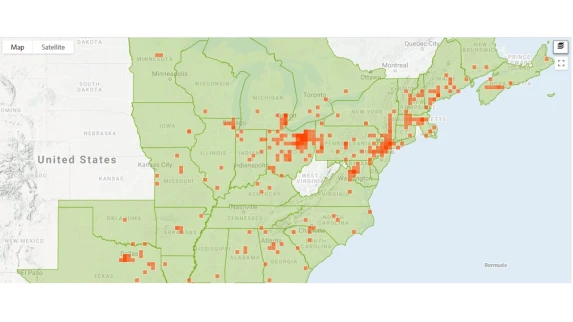
A 2014 update: When I wrote about these galls in 2013 I suggested that this was a two-year cycle and so I would predict that there would be no galls in 2014. Turns out my conjecture was right. I’ve looked and looked and none of my oaks have any galls this year. Next year will probably be the gall year.
August 2015 update: Around August 1st I saw the first small fuzzy galls on the same oak trees as they were on in 2013! Two weeks later we have tens of thousands of them and they are growing fast. They haven’t reached the size they did in 2013 yet but I am sure they will in the next few weeks. Below are some pictures I took on August 22, 2015 of the galls on the same two trees as those taken above.
August 2017 update: Like clockwork we observed thousands of galls appear on the tops of the leaves of the same oaks trees in the yard. The previous year (2016) we didn’t observe any so they are following the every-other-year pattern.
Fall 2018 update: No galls on the oak trees this fall. I expect we they will be back next year.
Fall 2019 update: Interesting year, very few galls. I had expected large numbers but I would estimate there were less than 1/10 of what there were the previous year.
Fall 2020: Wow, based on past history I didn’t expect to see galls but we have more than we have ever had before. Pinoaks are loaded and when they dropped (last two weeks of September) they formed a dense cover on the driveway and grass. Maybe the very mild winter of 2019/2020 resulted in more of them surviving. I have done some more reading and there are some other reports of them working on 2 or 3 year cycles so it seems that many of them waited an extra year this time around. Based on the comments below and the iNaturalist reports it appears that this year was a huge year for these plant galling wasps. It certainly seems they are becoming more common over the years.
This year I have saved more samples and I am hoping to do a bit of microscopy and will share pictures when I can. I also may try to extract some DNA or future DNA studies.
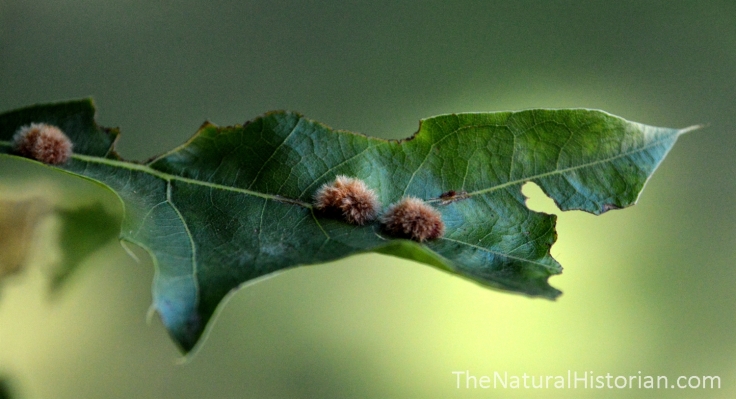
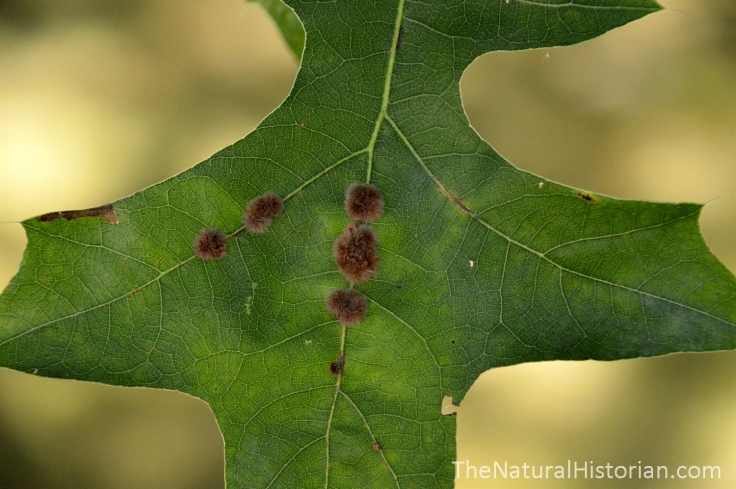


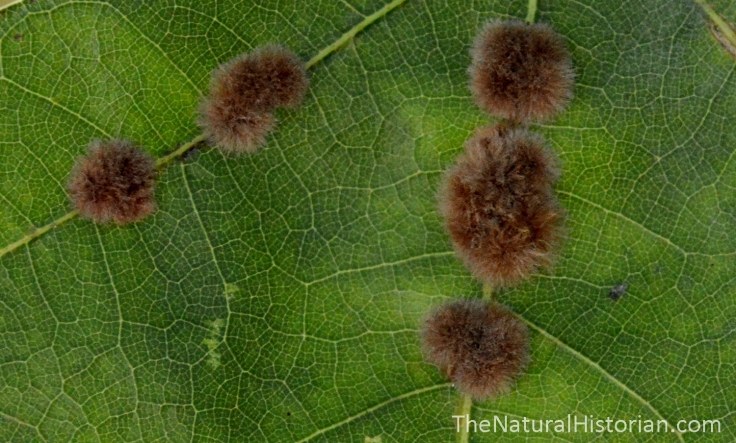
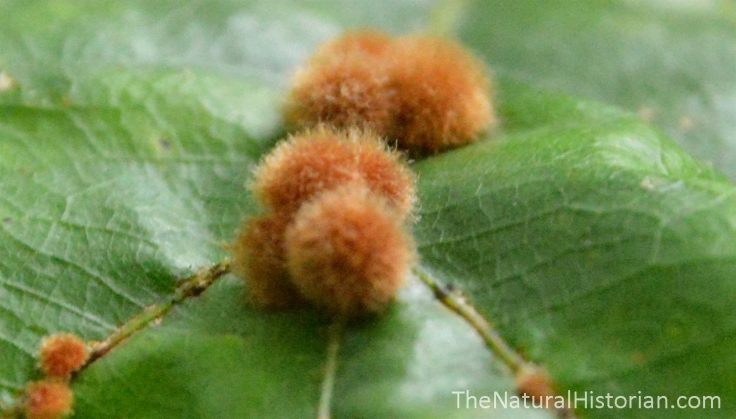
will there orange looking fuzzy galls kill my oak trees?
LikeLike
No worries there. It seems that they really do very little damages at all. They are not like a disease that sticks with the tree but rather just take a bit of extra energy from the tree which it has plenty to spare. The galls fall of of the leaves before the leaves fall and you can hardly even tell they were every there. Joel
LikeLike
Do we have an official ruling on whether this harms/adversely affects the oak? We discovered these galls this year and we definitely don’t want to lose our tree.
LikeLike
I don’t have any specific data to back this up but knowing biology and other studies of other pests I feel fairly confident that there is likely no big adverse affect. They grow late in the season by the time the tree has already gained most of the energy from its leaves and since the leaves are going to fall off anyway there it no direct damage to the tree. Its not like a virus or fungus which could infect the rest of the tree. Its contained to the leaves. To grow the gall requires some energy so it there was a particularly heavy infestation it might reduce the overall energy production of the tree but a large oak produces so much energy that this is not much of a concern.
LikeLike
Thanks for this article! I was wondering why I didn’t notice these last year when we moved into the house in the fall, and your 2-year cycle theory explains it perfectly! I live in central NH and before last night’s rain, the deck was absolutely covered with galls. Now they’ve been washed away except for the ones still clinging to the leaves that are falling. By any chance do you have a picture of the gall wasp?
LikeLike
Thanks. I really want to get some pictures of the wasps. This year I looked for them many time but could never catch them in the act. Its really amazing. There must have been 100s of thousands of them in our yard but they are so small they probably just seemed like gnats at times. There are only a couple of pictures on Google of the wasps so it would appear that they are are not easy to find or recognize.
LikeLike
2020 Ohio oak trees are full of these
+
LikeLike
Just found this page after seeing these in our yard in Charleston, SC!
LikeLike
This is an awesome article. I literally came in from being out in my backyard and wondered what those fuzzy things were. Thanks for taking the time to post this! :-)
LikeLike
I live in Central Florida, I have just seen them on our trees for the first time here. Never paid much attention to the trees before. But now that my job requires me to be outside more, I am more in tuned with what is going on outside.
LikeLike
I live in Jacksonville and never noticed them before either lol
LikeLike
I live in central florida, I am also very observant when it comes to nature, as I was an avid bug collector growing up. Not only have I never seen this in florida the past 12yrs, but neither in Ohio growing up, until today when I saw them in my Live Oak tree. But not in the touching hickory or citrus trees, I did see evidence of millions of egg sacks on the hickory leaves that were brown and brittle, dead looking, and did not have the brown fuzzy surrounding. Maybe they didn’t take to the hickory? I googled “brown fuzzy balls in oak tree” bingo, great post! I will be revisiting this post and doing some back yard research.
LikeLike
Very interesting. I really hadn’t noticed them here in Ohio until two years ago but then we had moved across town so maybe these wasps can be very localized. We had none this year suggesting they are on a two year life cycle so I will be watching closely this coming year to see if they show up again.
LikeLike
I grew up in Central Florida in older downtown Orlando where the streets are lined with old oaks. I have seen these fuzzy things all my life and never knew what they were. Julia
LikeLike
FABULOUS! Thank you for all your research and enlightening me and my family.
LikeLike
I’m in central Arkansas and they are all over our yard, thanks for researching ‘fuzzy things on leaves” for me! :)
LikeLike
Thank you, i was recently cutting down trees and found some of these and now I know what they are. I live in Northern Florida Palm Coast near Daytona Beach and it obviously is not an Oak tree it is on but apparently it is not particular to the tree itself. I have photos to share if you like.
LikeLike
Are they ok to collect? I too have 6-3&2 yr olds that love nature. Are we safe to place them on a jar for looking at?
LikeLike
Hi Lea, no problem collecting them. There are wasp larvae inside which are no big deal. Even if there were wasps they are stingless and wouldn’t harm anyone.
LikeLike
I live in the Coastal SC area and we have been overrun with these galls this year. Nobody seemed to know what they were, not even my tree guy-now I do and he does also.
LikeLike
Wow, so many stories from all over the eastern US of galls this year. Seems it was a banner year all around. Yours are probably a different species of wasp so it isn’t just that one wasp did well. Maybe the mild summer was good for lots of insects. It will be interesting to see if the huge numbers this year result in larger numbers in future years or if this was just the perfect storm of conditions for gall wasps.
LikeLike
I noticed them a few weeks ago on my oaks on the Central Coast of California. I thought my oak trees had grown flowers which is strange given that I’ve had these trees about 20 years and have never seen anything like them. They are red and fall off the leaf if touched even slightly. They seem to fade to beige after a while. Based on your pictures, I suspect it is some form of what you are talking about here — hopefully they will not damage the tree and don’t sting since there are a lot of them. Thanks for your excellent information.
LikeLike
Yes but will they kill my tree? I have a tiny little pib oak about 3 foot tall and they are all over it. The leaves are turning brown and I just planted it in May.
I grew this in a por until it got big enough to plant.
LikeLike
If they are the same thing that I have here it is not likely. If the galls appeared in the last month then the leaves have already done most of their job for the plant and any damage to them now doesn’t make much of a difference. The tree is going to shed those bad leaves for the winter and then get new ones next year. The leaves on a typical oak have already done enough making sugar from the sun by August that any damage to them will be almost meaningless. Now in the case of a newer tree it may slow its grown down a bit. If you whole leaf is turning brown that might be something different and not related to the insect galls. Not sure what would cause that.
LikeLike
I have just noticed these galls on the leaves of a pin oak yesterday for the first time while walking along the Montour Trail in suburban Pittsburgh. Thanks for the informative posting.
LikeLike
Thank you so much for this… I found them on a little Oak tree growing in my year. they remind me of “tribbles” from Star Trek. Interesting information … thank you for putting it together!
*Parma, Ohio*
LikeLike
I have lived in my home for 19 years and this is the first year I have ever seen these on my oak tree. I noticed today they are falling off all over the deck and yard…what happens to them after they fall off and mature? More wasp’s? I’m allergic to bees and wasp’s so I am probably paranoid. Thanks for the great article. I live in Central Ohio.
LikeLike
Hi, thanks for the feedback. Regarding your questions. When they fall off, the grub inside the gall will overwinter in the gall eating from the inside out. In fact, it will probably live in there for almost two years before coming out as a small wasp. Don’t worry about these wasps. They are tiny (just a couple of millimeters in length) and so are barely visible and they are only interested in getting their eggs into a new leaf. They are called stingless wasps because they have no stinger. You will almost certainly never know they are even in your yard until the galls how back up on the trees. It does seem their populations are growing as many people are noticing these for the fist time in their yards.
LikeLike
I have millions of these and no acorn’s what happened to the acorn’s
LikeLike
There is probably no relationship between acorn numbers and the galls. Acorns very quite a bit year to year in oaks. They generally cycle from very low numbers to big years.
LikeLike
Thank you as well for the information! I have lived in my home for 4 years in Martinsville, Indiana and just noticed the “fuzzy things” on the leaves of my pin oak tree a couple of weeks ago. My son and I were looking at them again this evening and I had to know what they were! Your article/post was the first to come up and was very informative. I’m amazed at how widespread they are!
LikeLike
I live in southwest Wisconsin in a heavily wooded area and we have millions of these fuzzy things everywhere in our yard. Im glad to finally know what they are! I have lived in this area for 15 years and this year was the first year I have ever seen them here.
LikeLike
Thank you for this info and the timely updates. Much appreciated! I see these fuzzy balls dropping from my neighbor’s oak tree this year; some are also still attached to dropped leaves. I live in central MD, by the way.
LikeLike
I live in central Ohio and have seen the same thing. Nice to know what they are.
I’ve been calling them “tiny tribbles”.
LikeLike
Ha, yeah tribbles is a great description. So my driveway is not covered with tribbles as they are dropping of the trees rapidly now. They need to detach from the leaves before the tree begins to pull the nutrients from the leaves before dropping them.
LikeLike
I have been wondering what these things are! I live in Cincinnati OH and they are everywhere this year, I sweep our porch every morning and by afternoon it is COVERED! I have not seen this many before, and never knew what they were. Interesting!
LikeLike
Thank you! These are exaclty what I have this year in MO. I appreciate the decently detailed explanation of what they are and how they will come and go. VERY happy to hear my tree will be okay.
LikeLike
I live in northern Ohio close to the lake,after two days of high winds,our deck was covered with oak leaves with these yellow balls all over the leaves.I like your daughter,thought they looked like some type of caterpillar.Thanks for the information you have provided.
LikeLike
I live in one of the Northwestern suburb towns of Washington DC ans found these red-yellowish stuff on my oak tree leaves. We went to local Home Depot store and was told they are fungus on the oak tree leave, and this oak tree disease needs to be treated with dormant oil. Is this information correct?
LikeLike
My mom has an oak in her yard with these galls but they are more beige/yellow than orange/red/brown. Everyone in her neighborhood has been wondering what they are. This is the first year of the galls in her tree and the only oak tree in her neighborhood to have them. She lives in Marengo County, Alabama.
LikeLike
Saw them for the first time in my yard in Birmingham, AL. Their “habit” fit what you said.
LikeLike
I wonder if these are related in any way to the much larger oak galls that we used to play with for “races” in our local creek. The ones I remember were about two inches in diameter!
LikeLike
“Tiny Tribbles, on the ground, tan and fuzzy, all around”… I suspect the gall wasp of being quite an affid eater as the years with Tribbles seems to be the years with low affid infestation on my mandovilla Plants! Great post, thank you.
LikeLiked by 1 person
TOO COOL! THANK YOU! :) I saw the first one I have ever seen on a fallen leaf two days ago. I am in Birmingham, AL and have lived here 20 years.
LikeLike
found a bunch in my yard. this is terrifying, thank you.
LikeLike
Did you just lead blow them out of your yard? How did you get rid of them?
LikeLike
There is no way to get rid of them. There are hundreds of thousands of them and aside from massive spraying of pesticides on the trees it would be difficult to eradicate and they would just come back from other place in the neighborhood in two years anyway. They aren’t that damaging to the tree and you won’t notice the wasps because they are so tiny and don’t bother humans so there isn’t much concern about trying to eliminate them.
LikeLike
Thanks for this great information. We have lived in our house with the same live oak tree since 2003, and have never these fuzzy guys before. Would the stress of a hurricane 1 year ago contribute to the appearance of the wasps?
LikeLike
Thanks. I think it is unlikely any stress on the trees would make them any more susceptible to the wasps. They are able to use very healthy trees and those trees aren’t really hurt much by them. What has happened is the wasps seem to be spreading to new areas and so they have moved into your area. It is possible that winds brought them to the area and now they are taking up residence. It is unlikely that there is anyone to get rid of them now but they are tiny and not going to bother people.
LikeLike
Thank you for your post and your annual updates! We just moved from the east coast to the Phoenix area so are just learning about desert plants. We have 3 desert oak trees that are COVERED with these little galls. Like you said – a half a million! You didn’t mention how many wasps actually emerge and if it is a problem. We have a terrible mosquito problem here in the desert (who knew!) and I’m not looking forward to a wasp problem. Thanks so much!
LikeLike
Should just be one wasp per gall. I’ve never noticed any wasps and I’ve looked for them so they must not spend much time right at ground level.
LikeLike
Just what I wanted to hear! Thanks for your insights!!
LikeLike
I’ve never seen them in such great numbers which spurred my interest, thx for the info. Old oaks in St. Pete.
LikeLike
My husband ran in to tell me he found these fuzzy balls that our four year old was squishing. He said they either had red or yellow stuff ooze out of them and had idea what they were. We live in Southwestern Georgia and have never seen them before. Thanks for making an outstanding blog and also all the other commenters too. I was really shocked to see how far and wide other people have been seeing and commenting on them too. Thanks again for all the information.
LikeLike
Did the gall ever hatch?
LikeLike
I wish I knew. I had my collection of galls in the garage in a plastic container but couldn’t find it in the spring. I suspect one of my kids knocked it over or used the container for something. I will have to try again this year.
LikeLike
Hi ! Thanks to your research I now know what the fuzzy orange balls on my tree are. I thought it was a plague and would have to cut it down!
From Missouri
LikeLike
Was searching the net for this info because I came across somilar furry balls in Malaysia. How about the few that you kept aside? What did they turn out to be?
LikeLike
Glad you asked. Unfortunately someone in my family must have though my container sitting in the garage was just trash and they threw it out so I didn’t get to see if anything would emerge. I’m going to try again this year.
LikeLike
Wow I Caught One today and I did not know what is was but now I do thx
LikeLike
I found this in my yard in Virginia Beach, VA today. 9/21/2019. This very large gall still attached to fallen oak leaf. I guess this is a giant gall.?
LikeLike
This is the first time I’ve ever noticed these here at my house in Columbus, MS, and I am out in the yard a lot…..I’m pretty sure I would’ve noticed them over the past 20 years. Wonder what’s going on??
LikeLike
Strange ! I fount one on a dead , fallen oak leaf and it looks much bigger than the ones in the picture . Also is it safe to touch them ?
LikeLike
I live in NE Ohio. August 2020 and I just found these on one of my trees!!
LikeLike
I’ve got a good ‘crop’ of them this year again so the even year pattern continues. I wondered if it being so dry might reduce the numbers but doesn’t seem to be case where I am.
LikeLike
Aha! I just found some on the property in Olmsted Twp, Ohio. So, your last date was 2018 and it’s now 8/30/2020. Since I’ve been sitting in that same spot since 2011 and have never seen any before, perhaps the oak gall wasp has just arrived here?? Got photo!
LikeLike
Very interesting. I have a good batch on my trees this year so the every even year pattern is still holding. I need to update this page.
LikeLike
Naperville, Illinois here. We have just noticed these this year. Have lived at this residence since 1987. Pin Oak Was planted in 1992 here. The deck surface, chairs, & hot tub cover are filled with them. We emailed our arborist and he said there was no cause for alarm. But it seems the leaves are falling off and turning brown, without turning the beautiful fall colors as it used to.
LikeLike
Ground is covered with fuzzy balls now as they have almost all dropped in the space of a week. I expect some of the problem with the leave this year is the hot dry spell which stressed the trees some. At least here in Ohio.
LikeLike
This is the first year we have seen the fuzzy galls and we have lived here since 1976. So glad that someone has posted pictures and the follow up from year to year.
We are not as worried now as we were before we read the articles. Thanks to all who posted.
LikeLike
We now have these fuzzy galls dropping everywhere this year – now covering the yard, deck, mulch, you name it. Live in Northeastern OH. We never had them before this year. It seems they are not dangerous, but can they be dangerous to my dog who loves laying in the yard and on the deck. Sometimes he will be laying on the deck and they just fall out of the sky pelting him. They seem more of a nuisance than anything else.
LikeLike
Yes our driveway is literally fuzzy. I’ve taken some pictures to add to this post in the next few weeks. Seems like more than ever. Maybe a milder winter allowed many more to survive the winter resulting in more wasps to produce galls this year.
LikeLike
I just saw these for the first time here in New Hampshire, and have been here for 45+ years. Will they survive the cold winter with snow? What kills them?
LikeLike
Not sure what will kill them but winter won’t though I suppose extremely low and extended temps would presumably kill many of them. We had a somewhat mild winter here in Ohio last year and a much larger number of galls this year so it seems that colder winters could deter them somewhat.
LikeLike
Wonderful information. Never heard of them before. I live in Texas and have seen a few. Just being aware has been a great education. Thanks for writing
LikeLike
What an absolutely fantastic piece! I’m fascinated with any aspect of coevolution, insects and their larval food plants are no exception, and it still amazes me how this process often forces insects to specialize on particular plant species — for an ecological classic, see Ehrlich and Raven (1964), “Butterflies and plants: a study in coevolution.” I too am from NE Ohio, and the parasitic wasp galls underneath pin oaks are easily in the 1,000s per square meter, and many still remain attached to the leaves and have yet to fall. Thanks again for an excellent natural history of this species, and your timelines of gall stage periodicity was much appreciated!
LikeLike
Does anyone know if the increased galls and acorns correlate with a cold long winter?
LikeLike
I found this site while trying to figure out what are these fuzz balls dropping from my oaks. I bought my house in the woods in NE Ohio 6 years ago and this is the first I have noticed these and the trees are loaded. I have to dump them out of the chairs by the pond before I sit down. They are falling like rain. My main concern is will they kill the trees. Not that I can do anything about the woods, but I might be able to treat around the house if I need too. If they won’t hurt the trees they are welcome to stay. I am normally not an insect sprayer.
LikeLike
I’ve never noticed these galls on our oaks in the previous 3 years at our house in Maine, but these galls are everywhere this year! It was a very dry year here, we are in a drought, so I wondered if that had something to do with it.
LikeLike
It was very dry here as well and I’ve been wondering the same thing. Either the trees are weakened or a natural enemy of these wasps has been knocked down allowing more of them to survive. Could also be a mild winter which allowed more grubs/galls to survive the winter.
LikeLike
Have never seen these galls in the 10years we’ve lived in our home here is SE Michigan. We have roughly 20 oak trees on our property. 2 weeks ago these fuzzy balls started showing up. It now looks like a popcorn machine exploded on my deck.
LikeLike
I’m hearing so many reports like yours. Seems like this parasite is rapidly expanding it range and population size. Thanks for letting me know.
LikeLike
I found these on my shingle oak (Quercus imbricaria) in the Lansing, Michigan region Sept 6. I had never seen them before. Shingle oak is in the red oak group. Thanks for your blog, which helped me Identify them. I will look for them on this tree in future years.
LikeLiked by 1 person
Thanks for writing. This is very helpful. I am interested in discovering how many different host species that this wasp can gall.
LikeLike